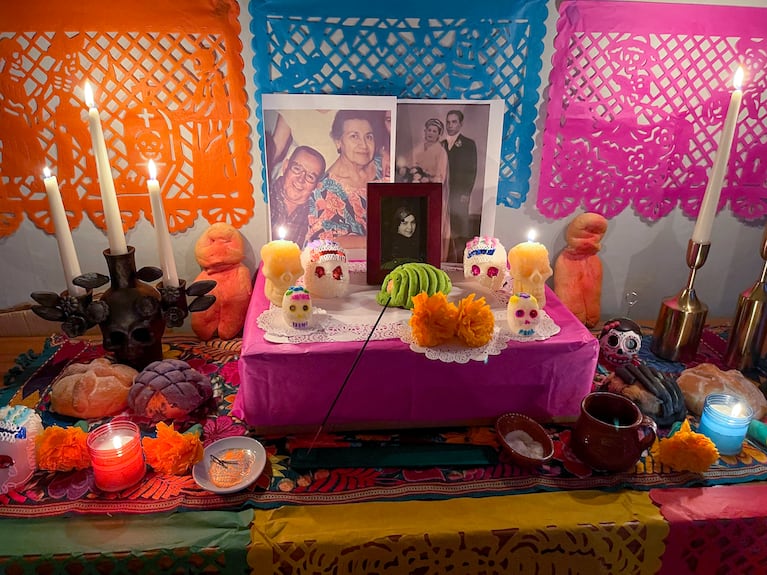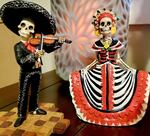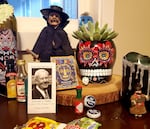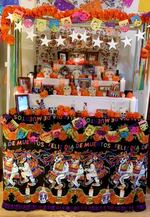
Dawn Jones Redstone shared this photo of her family’s Day of the Dead altar. “This is our altar. My daughter is named after my great aunt in the framed photo, Lucy Gonzales. She met her namesake very briefly before older Lucy passed away but they share a love of dance! We played videos of when they met and got to talk and celebrate their lives!”
Courtesy of Dawn Jones Redstone
The Mexican holiday Día de los Muertos — also called Día de Muertos, or Day of the Dead in English — has roots in Indigenous culture. According to folkloric tradition, the spirits of the dead have a brief window of time when they can visit their living relatives on Nov. 1 and Nov. 2. Here in the mortal world, people build elaborate altars, or ofrendas, to honor the memories of their loved ones. The ofrendas usually include photos of the dead, candles, bright orange marigolds, pan de muerto, sugar skulls, and some of the dead’s favorite things: foods, drinks or toys for children. These offerings are meant to help guide and tempt loved ones’ souls back to the living world to celebrate with their relatives.
Despite increasing commercialization of the holiday in the United States, Día de los Muertos is not the Mexican equivalent of Halloween. And it’s not a solemn day of mourning either. It’s a celebration: of life, and death, and the relationship between the two.
While the holiday is most often associated with Mexico, it’s observed by Mexican and other Latin American communities around the world, including here in the Pacific Northwest. We asked you what Día de los Muertos means to you this year, who you’re remembering, and what you’ve included in your ofrenda (and you sent us some pictures, featured in the photo gallery above). Here’s some of what we heard:
Maria:
“Hi, this is Maria Jose Dueñas. I’m from Guadalajara, living in Portland, Oregon ... Since I’ve been living in Portland, I’ve been honoring my father-in-law, making an altar for him. I put in some coffee that he used to love, some of the food that he used to eat — peanuts, snacks, vegetables — and of course, the pan de muerto as an offering. Some beer that he used to like to drink, the music that he used to love to listen to, I think one of them was Bob Dylan. I’m just trying to keep my roots, my customs. I used to do it when I was a kid, I didn’t do it later on because I was out of Mexico. Just trying to keep the celebration, and living in a different place. I know it’s a beautiful, beautiful celebration in different places in Mexico [about] food, family, love for the people that are no longer with us. I believe this this year is very special for more people, because a lot of people have gone with COVID.”
Zachary:
“Hello, my name is Zachary, and in memory of my family and ancestors from Sonora, Mexico, this year at the ofrenda we will be putting homemade carnitas and carne asada, as well as spreading awareness about our heritage and culture. I actually purchased some bumper stickers, just to spread awareness [that] we all have different heritages and we all have different family histories. I was born right here in Portland, Oregon ... just to spread awareness to everyone around us that there’s so many different cultures that are where you’re from.”
Maria:
“My name is Maria, I’m a Mexican American woman from Hawaii, and we’re now living in Portland. I’m making my ofrenda in my heart, because we’re in the middle of moving. I’ve been really thinking about my aunt that passed away, and we’ve been telling stories. There’s going to be Fireball, pan de muertos and Budweiser on there for her. For my grandmother, I’m going to have some of her favorite candies and spices. And for my grandfather, he’s going to have some beer too. I’m thinking about all the things that I can share with my children, stories that made me happy and that warmed my heart and taught me a lot, to try and keep their memory alive and to make sure that they aren’t forgotten.”
John:
“My name is John, I’m from Salem and I am celebrating Día de los Muertos, remembering mi abuela, as she is the reason of the person that I am today. When I came to the United States, she was my motivation, my encouragement to be in public service, as she was in Honduras. Every Día de los Muertos, I always remember her, I always put up a candle, and I remember the times that we’ve had. When she first came to the United States, it was quite magical. Very fun person to be with, and I truly, truly miss mi abuelita.”
Dawn:
“Hi, my name is Dawn Jones Redstone. I’m Mexican American, from San Antonio, Texas originally, and I’ve been in Portland for a long time now. We’ve been setting up our altar and teaching my seven-year-old daughter about what Día de los Muertos is. I’ve found, as I’ve gotten older, that death in general takes on a different meaning. It’s something that’s more in my thoughts. And it’s also just, in talking to her about it and teaching her, took on a new meaning, and created this moment between us, about what we are here to do, why we’re all here. So, we’ve been checking out some of the different local options for pan de muertos, and getting our sugar skulls (she just wants to eat them). We’re representing out here in the Pacific Northwest.”
Zhulma:
“My name is Zhulma, and I am from Ecuador. My home country is located in South America, and we celebrate Día de los Muertos a little bit differently than Mexican culture, mainly when we are talking about traditional food. Día de los Muertos ... it’s a merging of traditional Indigenous celebration with a Catholic holiday. In Ecuador, the tradition is for families to visit the cemetery, and take flowers and our food to those who have passed away. Also, some families like to hire musicians and bring them to the cemetery to play some music to the people who have passed away. The traditional food on this holiday is colada morada, which is a purple corn drink, and guaguas de pan, which is bread shaped as a baby. ‘Guaguas’ is the Quechua word for ‘babies.’ Some people also like to decorate their guaguas de pan, and add some sweet fillings inside. So, since my two kids were born here in the United States, I want to teach them about these Ecuadorian traditions. So this year I will teach them why we are celebrating these traditions here in the United States, and I will make some colada morada to teach them how it tastes and how to make it. And also I will buy some bread so they can decorate their own guaguas de pan, and celebrate together this special day for our family.”







